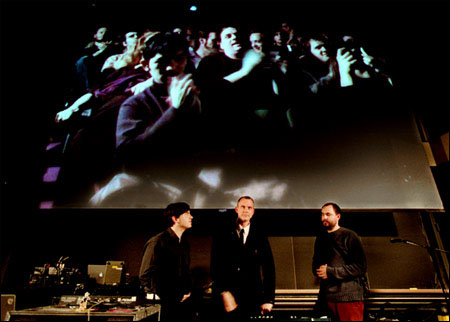Matmos makes music from found sound

They don’t do the duckwalk like Chuck Berry or the moonwalk like Michael Jackson. They don’t strut around the stage like Mick Jagger. They don’t play guitar with their tongues like Jimi Hendrix, and they don’t smash their instruments like The Who. What kind of musicians are they?
“We’re not musicians. We’re sound artists. Which of course seems even more pretentious,” said Drew Daniel, who, along with Martin Schmidt, is part of the San Francisco-based duo known as Matmos. The two are the 2002-03 Peter Ivers Visiting Artists, conducting a series of lecture-performances this week as part of the Office for the Arts’ Learning from Performers series.
Named after the living lake that feeds off the bad vibes of the planet Sogo’s inhabitants in the movie “Barbarella,” Matmos samples sound from a vast range of sources, then digitally alters those recordings to create musical compositions. They have recorded several CDs on the Matador label and last spring collaborated with the Icelandic singer/songwriter Björk on her “Vespertine” tour.

Matmos played a concert last Sunday (Nov. 17) to a packed auditorium in the Science Center, which included a live bird whistle performance by Schmidt, the sounds of an electronic probe that responds to the electrical impulses of the human body, and videotape of the audience projected on a large screen behind the performers.
At a workshop Monday, the duo lectured on “musique concrète,” the avant garde tradition with which they identify, playing a series of recordings that included vultures chewing on a zebra carcass, seals calling to one another under the Arctic ice cap, and a composition by French sound artist Pierre Henry titled “Variations for a Door and a Sigh.”
In their own compositions, Daniel and Schmidt have used recordings of amplified crayfish nerve tissue, the pages of Bibles turning, water hitting copper plates, liposuction, chin implant surgery, violins, violas, tubas, peck horns, human skulls, cards shuffling, conversations in hot tubs, frequency response tests for defective hearing aids, electrical interference generated by laser eye surgery, Polish trains, insects, dogs barking, rock salt crunching underfoot, the sound of a piano being dragged through the desert behind a pickup truck, and many others.
Typically, these sounds are altered – slowed down, speeded up, raised or lowered in pitch, chopped into momentary bits, and spliced into repetitive loops – until they are nearly unrecognizable. But what the sounds lose in identifiability, they gain in musicality. Many compositions are even danceable.
During their residency, the two have been recording sounds produced by the attendees at their workshops – shouts, coughs, hums, whistles, claps, keys tinkling, zippers zipping, performances with comb and tissue paper – nothing off limits. By the end of their stay, they will turn these sounds into a new composition, a Matmos-Harvard musique concrète collaboration. Get out your dancing shoes.




